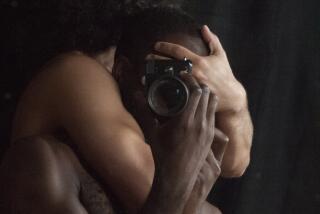Getting In on the Action
- Share via
At Fahey / Klein Gallery, a pair of solo shows by pioneering photographers Harold Edgerton and Eadweard Muybridge provide a captivating study of contrasts. Where Edgerton’s stop-action photographs of bullets tearing through balloons, playing cards and bars of soap deliver dazzling demonstrations of the camera’s superhuman capacity to reveal what is invisible to the naked eye, Muybridge’s less flashy yet more captivating images serve up a different type of delight. Depicting anonymous people and ordinary animals performing such simple tasks as walking, bending over or dumping a bucket of water over someone’s head, these sequences of pictures downplay technical wizardry in favor of getting viewers to pay close attention to the body’s mundane movement through time and space.
If you like movies filled with special effects, Edgerton’s color and black-and-white prints are probably up your alley--if not the source for such ubiquitous pyrotechnics. Anyone familiar with the history of photographic inventions is likely to have seen images by Edgerton, which are often reproduced in scientific textbooks and photographic manuals. Old standbys like the coronet-shaped splash formed by a single drop of milk and a bullet piercing an apple are included among the show’s 32 works, along with numerous, sometimes repetitive examples from such sports as tennis, football, golf, fencing and diving.
Two types of photographs make up Edgerton’s exhibition: single images in which exceptionally fast motions appear to be frozen, and multiple exposures made by a sequence of bright flashes. While the first type presents an inconceivably thin slice of time--as short as one three-millionth of a second--the second compresses an action that may take a few full seconds into a single image, showing, for example, a baseball bat’s various positions through a batter’s swing.
In 1932, Edgerton’s invention of stroboscopic, stop-action photography changed the way photographs looked. More important, they changed the way we look at the world.
Next to his stunning demonstrations of technical precision, Muybridge’s collotype photographs of humans and animals in motion look sweet and simple. But, if you like movies that forgo special effects in favor of mundane stories that speak of life’s basic wonders, images by Muybridge (1830-1904) cannot be beaten for consistently bearing witness to such fundamental satisfactions.
All of the 24 prints here were published in “Animal Locomotion” (1887), the photographer’s encyclopedic study of bodily movements, which included 781 plates and approximately 2,000 negatives. Nearly all of Muybridge’s prints consist of 10 to 12 thumbnail-size images, shot in rapid succession. Some sequences were taken from a single perspective, but most combine front, side and back views, giving viewers a fuller understanding of the body’s mass and agility.
Although there’s nothing dramatic or earth-shattering to be seen in any of these serial works, they sustain your attention for much longer than you’d expect. Muybridge’s photographs of a woman dropping and picking up a handkerchief or a man ascending an incline capture the remarkable grace and dignity of the human form in action. Part of the power of his art resides in the fact that the activities it depicts could be performed by almost anyone.
BE THERE
Fahey / Klein Gallery, 148 N. La Brea Ave., (323) 934-2250, through Sept. 5. Closed Sundays and Mondays.
More to Read
The biggest entertainment stories
Get our big stories about Hollywood, film, television, music, arts, culture and more right in your inbox as soon as they publish.
You may occasionally receive promotional content from the Los Angeles Times.










